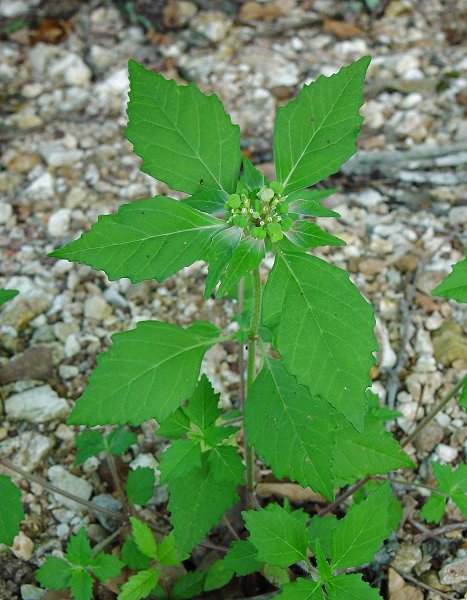Euphorbia dentata Michx.
Toothed Spurge

Native
CC = 0
CW = 5
MOC = 71
© DETenaglia
Euphorbia dentata Michx.Toothed Spurge | |
 |
Native CC = 0 CW = 5 MOC = 71 |
© DETenaglia |
|
Family - Euphorbiaceae Habit - Taprooted annual forb, with milky sap.
Stems - Ascending to erect, to 60 cm, multiple from the base, often branching, the branches not flattened toward the tip, usually green to yellowish green, occasionally reddish-to purplish-tinged, densely pubescent with minute, downward-angled hairs, usually also with scattered, longer, multicellular hairs.
Leaves - Mostly opposite, simple, petiolate. Petioles to 1.5 cm long, pubescent, with a shallow adaxial groove. Stipules absent or a pair of minute, light brown, convex, sessile glands. Leaf blades 10-60 mm long, highly variable in shape, linear to lanceolate to nearly circular, not lobed, more or less symmetrically rounded to angled or tapered at the base, rounded or angled to tapered to a usually bluntly pointed tip, the margins relatively coarsely and often irregularly toothed or less commonly finely toothed to scalloped, wavy, or nearly entire, the surfaces sparsely to densely pubescent or occasionally nearly glabrous, green to dull grayish green and sometimes reddish- to purplish-tinged toward the margins or base, the undersurface with somewhat longer, relatively slender, non-pustular hairs and paler green than the upper surface.
Inflorescences - Terminal, small, umbellate panicle with a whorl of leaves at the base, frequently reduced to 1-3 small clusters of cyathia, glabrous.
Flowers - Involucre 2.5-3.5 mm long, glabrous, the rim irregularly lobed and fringed, often with a pinkish tinge, the marginal glands 1 or more commonly 2, 0.7-1.2 mm long, appearing strongly concave and more or less 2-lipped, yellowish green to yellowish brown, lacking a petaloid appendage. Staminate flowers 25-40 per cyathium. Anthers bi-lobed, yellow, .5mm broad. Filaments white, glabrous, distinctly jointed in the apical 1/4. Ovaries glabrous, the styles 3, white, glabrous, 1.0-1.5 mm long, each divided 1/2-2/3 of the way from the tip into 2 slightly club-shaped lobes.
Fruits - Capsules 3-5 mm long, 3-lobed, glabrous. Seeds 2.5-3.0 mm long, ovate to broadly ovate in outline, more or less rounded in cross-section (the oblique apical portion surrounding the caruncle angled but the longitudinal inner faces appearing rounded), more or less flattened to slightly concave at the base, the surface appearing relatively finely warty or with fine, relatively evenly spaced tubercles, light gray to dark brown or nearly black, often appearing somewhat mottled, often with a small but well-developed, pale caruncle.
Flowering - July - October. Habitat - Streambanks, ledges and tops of bluffs, forests, glades, upland prairies, fields, gardens, ditches, railroads, roadsides, open disturbed areas. Origin - Native to the U.S. Lookalikes - E. davidii, E. cyathophora. Other info. - This species is found throughout Missouri, and also across much of the southern half of the continental U.S. The plant is generally inconspicuous because of its minute flowers and somewhat nondescript appearance; however with a little practice it is easily identified. The leaves are most commonly ovate and coarsely toothed, and the plant is topped with a knobby-looking inflorescence. The pea-sized, 3-lobed fruits are far more visible than the flowers. The plant strongly resembles the closely related E. davidii, and in fact the two can be difficult to distinguish. The latter plant has leaf hairs with more pustular bases, producing a rougher texture on the leaf underside. That species also has seeds with broad, lumpy warts on the surface. Photographs taken in Ellington, MO., 7-7-03 (DETenaglia); also along the Katy Trail near Dutzow, Warren County, MO, 9-16-2011 and 9-16-2018 (SRTurner). |